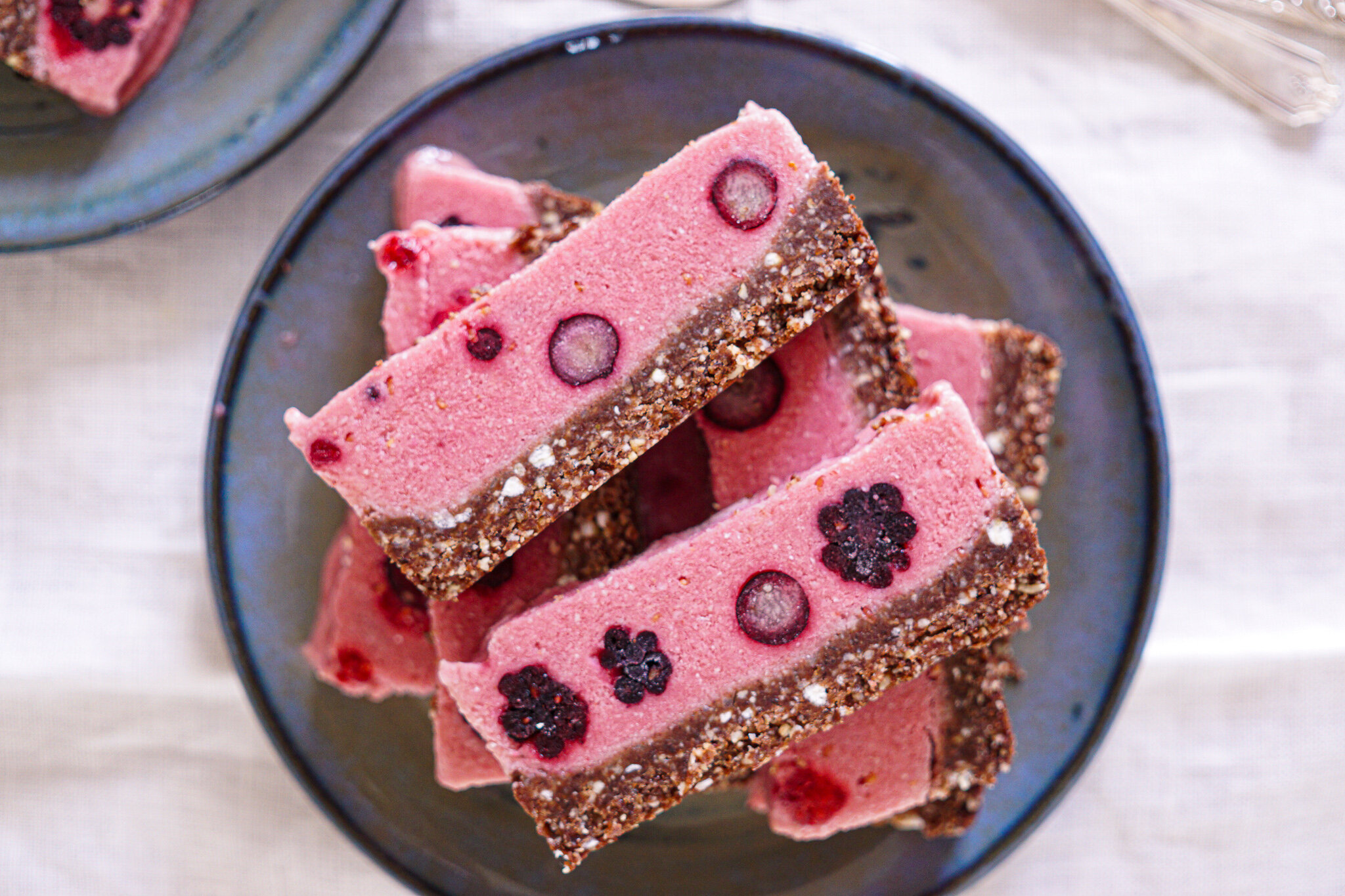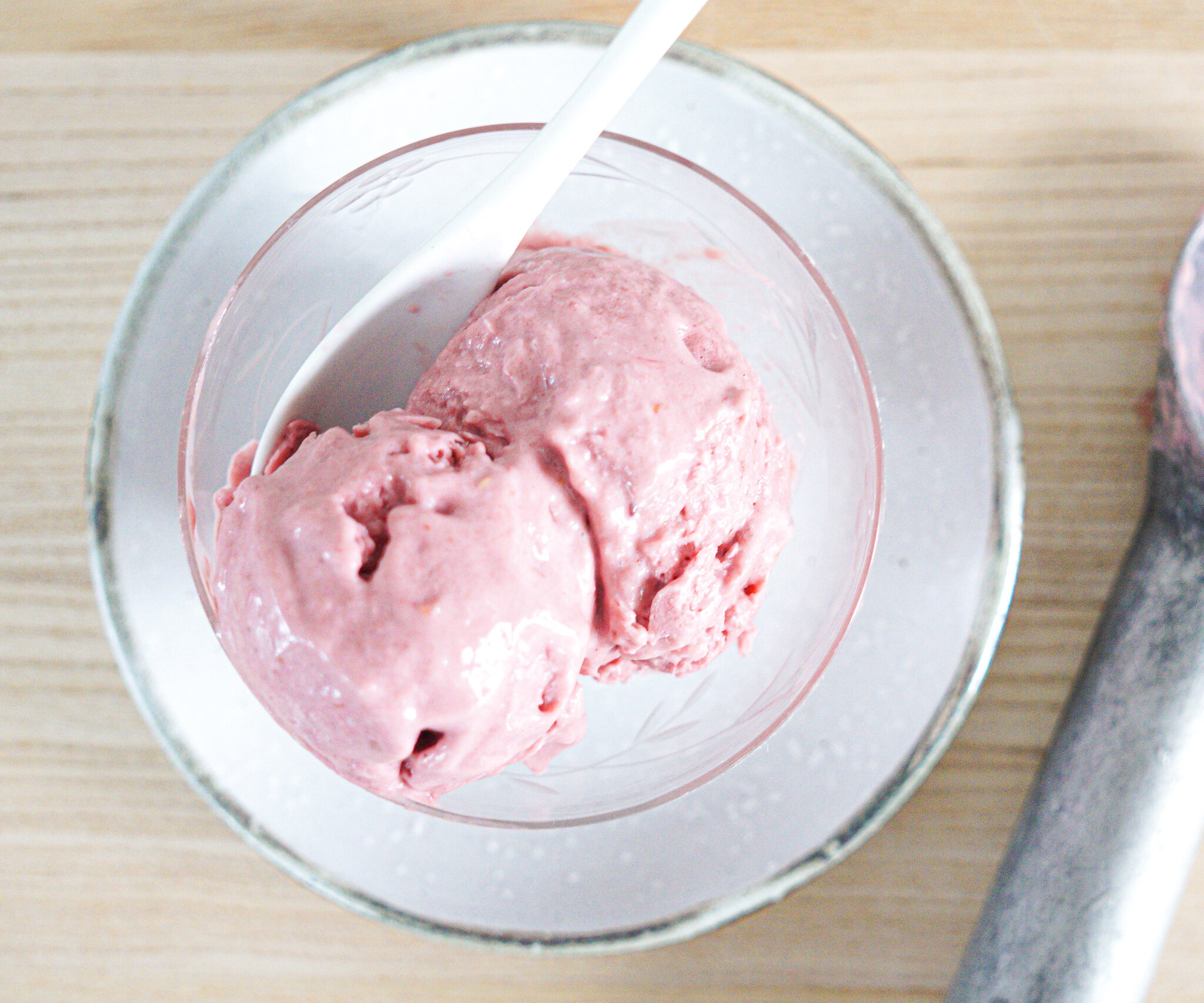Tomorrow is the official start of summer! We are looking forward to long, hot summer days, punctuated with cool, refreshing frozen treats.
One of the top ways that we can eat better for ourselves without harming the planet is to avoid highly processed foods, particularly those that contain cow’s milk from intensive feedlot farms – yes, unfortunately that probably includes your favorite tub of ice cream. Supply chains can often be murky and frustrating to understand, so why not skip the headache of it all and make your own homemade ice cream this summer? When it’s this easy, there’s no excuse, you don’t even need an ice cream machine! The first recipe here is a bright and tangy rhubarb and strawberry ice cream using coconut milk for creaminess and a bit of coconut oil for texture. There’s no getting away from the fact that no-churn ice cream is slightly icy but there are plenty of upsides to make it worthwhile. The ice cream bars are a real crowd-pleaser and the perfect make-ahead treat for summer parties and kids snacks.
While coconut milk is a great replacement for cow’s milk as a crop that requires little water or other resources to produce, there are issues around virgin forest being cleared for coconut farms and questionable working conditions on some farms. Try to seek out fair trade brands that source from sustainable farms. This also applies to other coconut products like desiccated coconut and coconut oil.
Rhubarb, Strawberry and Coconut (No-churn) Ice Cream
Rhubarb and strawberries are natural spring companions.The rhubarb season in France is pretty short, so we like to freeze the fruit at the height of the season, pre-cut into small batons, so that we can enjoy it for just a little longer.
Equipment : kitchen foil, a blender or a food processor, a freezer-proof dish with a lid
Ingredients
5 stalks (about 7 ounces, 200 g) fresh or frozen rhubarb (thawed if frozen)
2/3 cup (7 ounces, 200 g) fresh or frozen strawberries, green tops trimmed if fresh
2 tablespoons coconut sugar
1 3/4 cup (400 ml) sustainably sourced full-fat coconut milk
4 tablespoons maple syrup
4 tablespoons expeller-pressed coconut oil, melted
2 teaspoons vanilla extract
1/8 teaspoon salt
Method
Centre a rack in the oven. Preheat the oven to 350°F (180°C).
Place the rhubarb, strawberries, and coconut sugar in a medium sized oven-proof dish and cover with foil. Roast until soft enough so you can easily pierce the rhubarb with a tip of a knife, about 30-35 minutes.
In the blender, place the coconut milk, maple syrup, coconut oil, vanilla extract, salt and the roasted rhubarb and strawberries. Blend until completely smooth. Transfer to the freezer-proof dish with the lid and place in the freezer to set, for at least 6 hours. Stirring the mixture every half an hour with help to break up any crystals that form but isn’t essential. Serve when just frozen. If left overnight to set, the ice-cream will likely have frozen to very hard. For a scoopable texture, allow to thaw slightly, scoop out and reblend in the blender, then either eat straight away soft-serve style or return it to its container and allow to set until firm for a couple of hours.
Variation
If you don’t want to turn the oven on a hot summer’s day, skip the roasting and replace the rhubarb with 10 ounces (300 g) grams raspberries, strawberries or mixed berries. Fresh are wonderful, but frozen can really help speed up the freezing time.
RASPBERRY AND COCONUT
(NO-CHURN) ICE-CREAM BARS
These store brilliantly, pre-cut and wrapped in parchment paper, ready to be pulled from the freezer anytime you need them and devoured in the sunshine.
The buckwheat groats aren’t essential, but they do add a nice crunchy texture to the base. If you can’t find them, simply add extra 2 tablespoons of hazelnuts. We’ve used raw cacao powder which hasn’t been heated and so retains a lot the nutrients that get lost in processing. If tricky to get hold of replace with regular cocoa powder.
Makes 12 ice-cream bars | Equipment : a food processor or a blender, 10x4-inch (25x10-cm) loaf tin, biodegradable parchment paper
Ingredients
For the base
3/4 cup hazelnuts
2 tablespoons buckwheat groats
3 tablespoons desiccated coconut
2 tablespoons raw cacao powder
1/4 teaspoon ground cardamom (optional)
1/8 teaspoon salt
7 large plump dates, such as medjool or mazafati, pits removed
1 tablespoon expeller-pressed coconut oil
For the ice-cream
1 3/4 cup (400 ml) sustainably farmed coconut milk
1/4 cup organic honey or maple syrup
1 1/2 cups fresh or frozen raspberries
2 tablespoons almond butter
4 tablespoons coconut oil, melted
1/8 teaspoon salt
1 teaspoon lemon juice
1/2 cup mixed frozen berries
Method
1. Centre a rack in the oven. Preheat the oven to 350°F (180°C).
2. Place the hazelnuts in a small oven-proof tray and roast until beginning to color slightly, about 5 minutes. Remove from the oven and set aside. Once they are cool enough to touch, rub the hazelnuts vigorously between your palms to remove the skins – don’t worry if some small bits of skin remain.
3. Place the hazelnuts in the bowl of the food processor and process until beginning to form fine crumbs. Be careful not to over blend or it will start to become hazelnut butter and will release too much oil. Add the buckwheat groats and desiccated coconut and process again so that the mixture resembles coarse sand. Add the cacao powder, cardamom (if using) and salt, and process again to combine. Finally add the dated and coconut oil and process until well combined and the mixture begins to come together. When squeezed together in the palm of your hand, the mixture should hold together.
4. Line the loaf tin with the parchment paper so that the edges hang generously over the sides, creating flaps. This will make it easier to remove the ice-cream once frozen.
5. Transfer the mixture into the lined pan, pressing down with the back of a spoon to flatten it evenly across the base. Place in the freezer to chill.
6. In the food processor or blender, combine the coconut milk, maple syrup, raspberries, almond butter, coconut oil, salt and lemon juice and process until completely smooth. Note that using a blender tends to give you a smoother result.
7. Remove the loaf pan from the freezer and pour the mixture over the base. Return to the freezer to set, stirring every half hour of so for 1-2 hours, being careful not to disturb the biscuit base. As the mixture begins to thicken as it freezes, add the frozen mixed berries and stir gently to evenly distribute. It’s best to add the berries at this stage to ensure that they are suspended in the ice cream and don’t all fall to the base. Return to the freezer until completely hard, about 4-6 hours more.
8. To remove from the pan, gently slide a knife between the pan and the parchment paper. Lift the ice-cream out of the pan using the parchment paper flaps. Place on a clean chopping board and slice into 12 servings. Serve immediately, or store in the freezer, individually wrapped in small pieces of parchment paper.
This is a Nourish the Planet recipe, part of a collaborative series by Patricia Wells and Emily Buchanan.
© 2020 – All rights reserved. Please do not reproduce without permission.
Find our more here about why we created this series.



